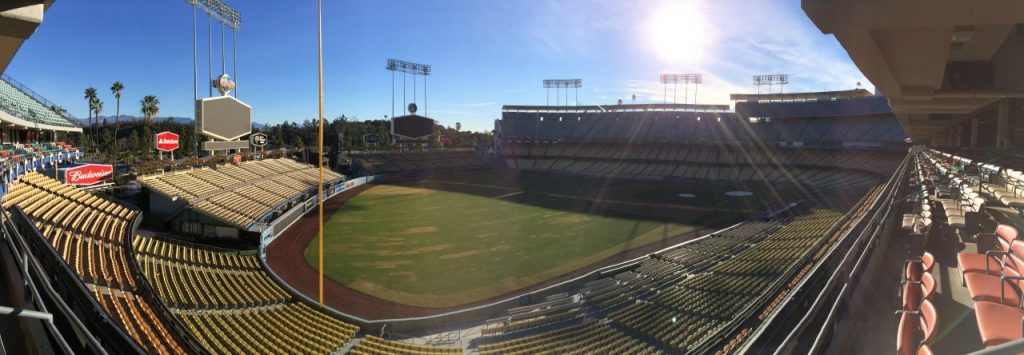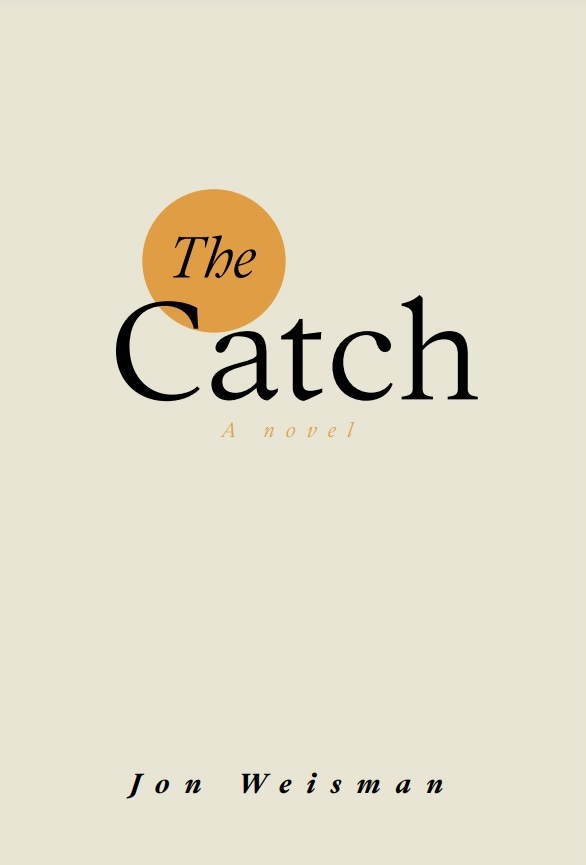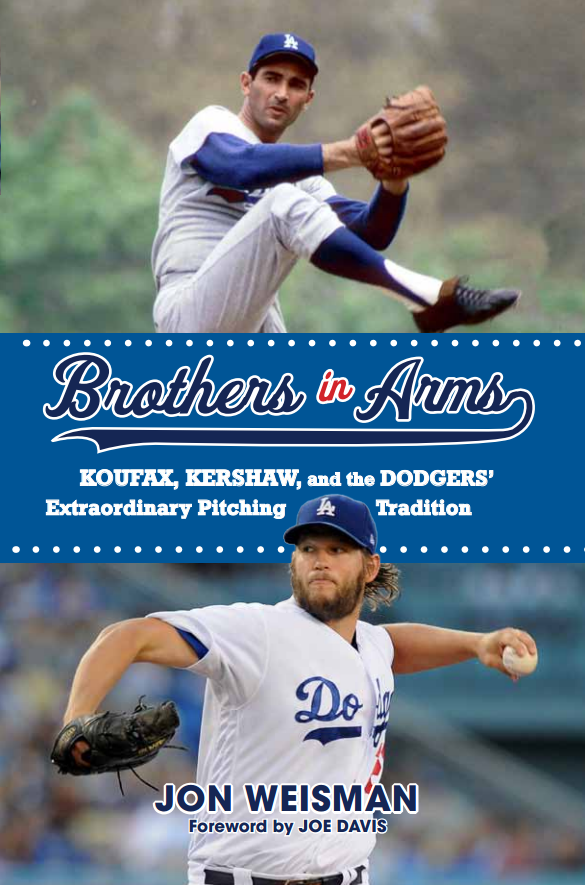Rod Barajas, who injured his hamstring in the Dodgers’ 8-2 victory over Colorado on Friday, is waiting to see if he can avoid the disabled list. He joins Andre Ethier (infected toe) and Casey Blake (the mind is willing, the body isn’t) on the sidelines today.
Author: Jon Weisman (Page 286 of 379)
Is Ned Colletti a viable candidate to replace fired Cubs general manager Jim Hendry? Mike Petriello addresses the speculation at Mike Scioscia’s Tragic Illness.
As exciting as it’s been to see Javy Guerra, Rubby De La Rosa, Josh Lindblom and Nathan Eovaldi trip from Double-A to the majors, the missing passenger on that ride for the 2011 Dodgers has been a minor leaguer who can actually hit.
How’s this: The No. 1 active hitter in the Double-A Southern League is Dodger prospect Scott Van Slyke.
The only guy atop Van Slyke in OPS in the Southern is Paul Goldschmidt, who was called up by Arizona and now has a .353 on-base percentage and .596 slugging percentage for the Diamondbacks in his first 15 games. In Double-A, Goldschmidt was at .435 and .626.
Van Slyke, who turned 25 last month, now sits at .422 and .570 while splitting time between first base and the outfield, positions where the Dodgers look thin next year even if Jerry Sands comes through. Van Slyke has 42 doubles in 405 at-bats to go with 14 home runs, and 57 walks against 87 strikeouts.
Of late, he has accomplished the pretty feat of having two hits, three hits, four hits and five hits in his past four games, capped by a 5-for-7 performance in Thursday’s 12-11 extra-inning loss.
Van Slyke had a .907 OPS with High-A Inland Empire in 2009, then struggled a bit when he moved up to Double-A in 2010. But he has more than adjusted. He’s on the old side for his level, so we’re not looking at a future Hall of Famer, but we should at least be looking.
When I started wondering about 2012 back in May, I mentioned Van Slyke, thanks in part to his hot start but more so to the fact that I needed bodies to fill out my 2012 lineup. In other words, it wasn’t exactly with a strong belief that he would or even could actually start next year.
However, with Trayvon Robinson off to Seattle, and the Dodgers possibly having as little to spend in the offseason as they’ve had in years, Van Slyke probably needs to be taken more seriously. After all, his .992 OPS in the tougher hitting environment of Double-A is higher than Sands’ .907 OPS in cozy Triple-A, and he has a better walk-strikeout ratio as well. (He’s also better in the latter category than the otherwise hot-hitting Alex Castellanos, who came to the Dodgers in the Rafael Furcal deal and now has a .972 OPS in 2011).
Here’s the starting lineup the Dodgers will arguably take into the offseason, before any free agents (their own or from other teams) are signed or any trades are made:
A.J. Ellis, C
Scott Van Slyke, 1B
Justin Sellers, 2B
Dee Gordon, SS
Juan Uribe, 3B
Jerry Sands, LF
Matt Kemp, CF
Andre Ethier, RF
Little has been said about Van Slyke as a prospect, but he hardly looks like the weakest hitter in that group. Even if he struggles at the outset of his major-league career, he might be worth investing some hope in.
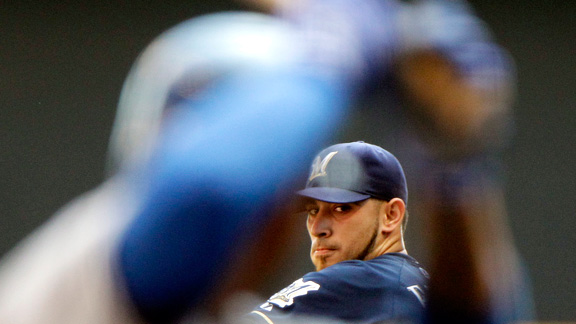
Morry Gash/APThe Dodgers could see right through Marco Estrada of Milwaukee today.
At the risk of taking Clayton Kershaw for granted, let’s bypass his latest sterling effort — eight shutout innings in the Dodgers’ 5-1 victory over Milwaukee today — and make our periodic foray into a Bullpen Usage 101. Or maybe it should just be Bullpen Usage 1.
Of course, you know the drill by now, the age-old vexation, the pure folly that is refusing to use your top relievers in a tie game in order to preserve them for a save opportunity that might never come. That’s what happened Tuesday, when the Dodgers used the 2011 version of Hong-Chih Kuo and the 21st-century version of Mike MacDougal in a 1-1 ballgame in the bottom of the ninth rather than the Javy Guerra and his scoreless streak of 11 1/3 innings.
[Aside: Kuo was taken out immediately after walking the only batter he faced, Prince Fielder, with Don Mattingly being quoted as saying that he was monitoring Kuo’s usage in an attempt to build his confidence. Now, read that sentence and tell me if you see the logic flaw there.]
Anyway, the Dodgers gave up the run they couldn’t afford to give up Tuesday and lost. Then, when they could afford to give up four runs and still win today, they brought in Guerra and his 1.57 ERA.
For weeks, Mattingly refused to identify Guerra as his closer, but now he’s become so rigid with Guerra that he doesn’t see fit to use him any differently than Jim Tracy used Eric Gagne in his Dodger heyday. And that rigidity itself is ironic, because it was Mattingly’s flexibility in using Guerra as his ninth-inning stopper — ahead of a veteran with saves and All-Star credit like MacDougal — that gave birth to Guerrarama.
That Guerra allowed a run today doesn’t change what the best odds were for the Dodgers.
Someday, managers will stop trying to explain why they think a lead in the 10th is more pressure-filled than a tie game in the ninth, and actually just do the right thing. Mattingly should seize the opportunity to be that man. To paraphrase “Say Anything”: “The world is full of guys. Be a manager.”
* * *
OK, I can’t ignore Kershaw completely.
Kershaw threw only 104 pitches in his eight innings. In the sixth, he was nursing the 1-0 lead that Rod Barajas’ 11th home run of the year provided when the Brewers put runners on first and third with one out, and MVP candidates Ryan Braun and Fielder due up.
The 23-year-old retired each batter on the first pitch to get out of the inning. To do so that economically was something of a fluke, but it sure wasn’t surprising, and it’s that kind of confidence that Kershaw is inspiring that is only adding to his legend.
Kershaw is now at a league-leading 199 strikeouts for the season and five wins away from 20, the latter as cool as it is meaningless. Twenty-three years old.
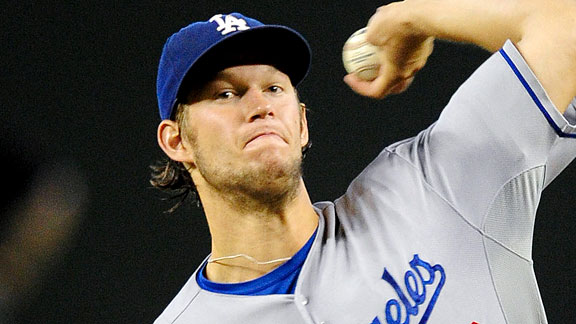
Matt Kartozian/US PresswireClayton Kershaw has approximately eight starts remaining to burnish his Cy Young chances.
As the sub-.500 Dodgers go for their unlikely and incongruous double play – Matt Kemp for National League Most Valuable Player, Clayton Kershaw for NL Cy Young – you’ll find that Kershaw is the clear leader among pitchers from non-contending teams.
Kershaw has a 2.72 ERA, an NL-best 9.89 strikeouts per nine innings and 4.9 wins over replacement, according to Fangraphs. With a quarter of the season remaining, none of the other pitchers from the Losers Division match up. In ERA, the only challenger is Cincinnati’s Johnny Cueto (1.87), who has thrown nearly 50 fewer innings. Florida’s Anibal Sanchez has a strikeout rate of 9.33, but his ERA is 3.97. And the next best in WAR from a losing team, 3.6 by Washington’s Jordan Zimmermann (3.23 ERA), is more than 25% lower than Kershaw’s. If you look at other stats, you’ll find similar lack of competition.
But there are stout rivals for Kershaw among contending teams:
- Roy Halladay. We discussed Halladay as a leading MVP candidate, so naturally he belongs atop this list. Halladay has everything, from Old School wins (15, tied for the league lead) to New School WAR (6.7). The latter leads the NL by a wide margin. Given Philadelphia’s dominance of the league, Halladay is the logical favorite if you’re handicapping this race.
- Cliff Lee/Cole Hamels. There’s a pretty strong possibility that voters could place Phillies first, second and third on their NL Cy Young ballots. That depends in part on the health of Hamels, who just missed one start because of shoulder inflammation. But if Hamels comes back, he will be all but neck-and-neck with Lee: 2.62 ERA vs. 2.82, 8.11 K/9 vs. 9.25, 5.0 WAR vs. 4.9.
- Tim Lincecum. It’s a bit easier to sell the idea that Lincecum is no longer the best pitcher in the NL West, but then again, maybe he is. He has a small edge on Kershaw in ERA and park-adjusted ERA; Kershaw’s winning on strikeout rate and WAR. I feel like I’m hearing Kershaw’s name mentioned with more vigor in the Cy Young conversation than Lincecum’s, but big September performances by the Giant righty could reverse that.
- Ian Kennedy. Like Arizona in the pennant chase and Justin Upton in the MVP race, Kennedy is coming from behind with vigor (13-2, 2.74 ERA since April 25). With Atlanta’s Jair Jurrjens sadly hitting the skids (29 innings, 6.52 ERA since the All-Star Break), one hurdle fell out of Kennedy’s way. It seems impossible to think that he could top all the Phillies, but he’s positioned himself to be in the conversation and steal some votes from Kershaw, especially from those who value wins (he’s tied with Halladay with 15) over WAR (3.2).
- John Axford/Craig Kimbrel. The closers for the Brewers and Braves have had fine seasons. Axford has struck out 11.0 per nine innings with a 2.31 ERA (he’s inherited only one runner all year), while Kimbrel has a 1.81 ERA and a massive 14.2 K/9 (four inherited runners, all stranded). But the starting pitching alternatives are too strong.
The list of rivals for Kershaw isn’t long: As of now, it’s just three Phillies and Lincecum, with Kennedy and Cueto lurking. But while Kemp might only need to maintain an edge in the NL MVP field – a challenge in its own right – Kershaw will have make up statistical ground on at least Halladay, while also overcoming the impression that his performance didn’t come in high-stakes contests or as challenging a circumstance (pitchers’ park, anyone?).
Kershaw is close enough that a down-the-stretch surge could put him in Trophy Town, but no matter what, he’ll need some dominoes to fall his way.
Even though Nathan Eovaldi surrendered the 0-0 tie with his final pitch in the sixth inning of tonight’s 3-1 Dodger loss to Milwaukee, he still has a space among this season’s much-needed pleasant surprises.
Eovaldi gets himself in trouble, walking nine in 17 innings so far, but his 2.12 ERA has been fun nonetheless. As has Josh Lindblom (despite his three bases worth of wild pitches tonight, thanks in no small part to the sloppy catching of Dioner Navarro). As have Scott Elbert and Javy Guerra, and Rubby De La Rosa and Dee Gordon before they got hurt, and Jerry Sands before he was sent back to Albuquerque. Not to mention a small dose of Aaron Miles and Juan Rivera, the strikeout tear of Kenley Jansen, the stately poise of Hiroki Kuroda and, of course, the explosions of Matt Kemp and Clayton Kershaw.
Heck, let’s even throw Tony Gwynn Jr.’s highly unexpected and possibly unauthorized home run tonight into the mix.
What’s your favorite happy surprise of the 2011 Dodger season? If you prefer, pick two, to match the number of runs the Dodgers scored in their three games against the Brewers.
- .280 on-base percentage, .336 slugging percentage, 71 OPS+ with Seattle in 2010.
- .393 on-base percentage, .471 slugging percentage, 147 OPS+ with Tampa Bay in 2011.
The key: After being cut loose by the Mariners in November, Kotchman signed a 2011 contract with the Rays for $750,000.
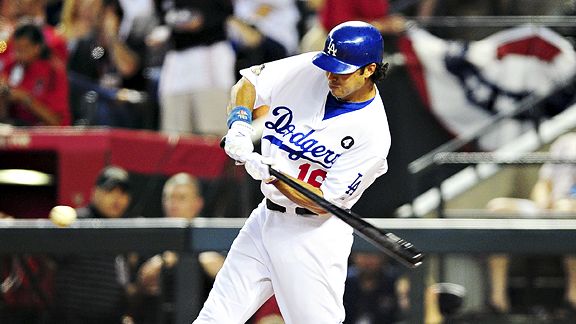
Mark J. Rebilas/US PresswireAndre Ethier’s slugging percentage has fallen from .493 in 2010 to .428 this season.
Andre Ethier’s OPS has dropped below .800 for the first time since April 3. He has 10 home runs this season and one in his past 107 at-bats. All this is feeding some simmering frustration about his 2011 performance and even making me wonder to myself ever so briefly whether he might be on a downward, James Loney-like trajectory.
And then, you take a step back and see that in 2011, Ethier has …
- a .294 batting average that is .002 higher than last year’s and .003 higher than his career average.
- a .367 on-base percentage that is .003 higher than both his 2010 and career averages.
- 5.71 doubles per 100 plate appearances, compared with 5.64 in 2010 and 5.84 in his career.
Most of Ethier’s game is the same as it ever was. Except for this one thing.
- Ethier has 2.04 home runs per 100 plate appearances, compared with 3.93 in 2010, 4.53 in 2009 and 3.27 for his career.
I’ll say up front that I don’t know the reason for this — though I still don’t believe it has anything to do with his early season hitting streak. Ethier was showing little home-run power even before it really got going, and has had plenty of time to self-correct since it ended on May 7. That being said, Fangraphs shows that Ethier’s line-drive and ground-ball rates have risen to near-career-high levels, while his fly-ball rate is the lowest it has ever been.
Just another observation in passing — Ethier seems to be having particular trouble with sliders this year.
But the kicker is this: According to Fangraphs, Ethier has been more valuable this year than he was in 2010 or 2009, thanks to what the site reports as a dramatic improvement in his fielding. I know numerous people take advance fielding metrics with a grain of salt — thanks in part to wild fluctuations like these — but it’s something to consider.
First of all, all I want to say is thankfully Chad Billingsley pulled together seven innings of one-run ball, retiring, you know, most of the guys he faced after the first couple of innings.
Second of all, there’s going to be no second of all, because I’m under the weather. I didn’t see the ninth inning, but I get the sense it wasn’t good.
Tim Dierkes of MLB Trade Rumors provided the fun conversation topic of the day, suggesting that the Cubs might consider trading troubled starting pitcher Carlos Zambrano — and cash — for woebegone Dodger infielder Juan Uribe.
Of course, anytime Milton Bradley’s name comes up for comparison’s sake, many people will have strong feelings. Conversely, my initial response was to be intrigued by the possibility of Zambrano (.848 OPS this season) playing first base and batting sixth, but Mike Petriello of Mike Scioscia’s Tragic Illness weighed things a bit more carefully.
Elsewhere, Steve Dilbeck of the Times points out that the three leading National League Manager of the Year candidates — Arizona’s Kirk Gibson, Milwaukee’s Ron Roenicke and Philadelphia’s Charlie Manuel — are all ex-Dodgers.
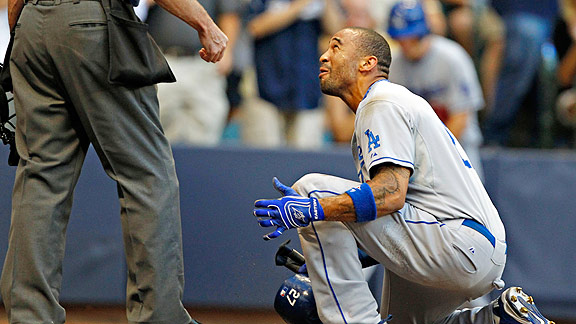
Jeffrey Phelps/APMatt Kemp pleads for mercy.
There’s probably no correlation between being on the wrong side of a triple play and being on the wrong side of the pennant race. But poetry doesn’t fret over correlations.
And so you had the Dodgers reentering the world of competitive baseball after that three-day break against Houston, and before the sun set finding themselves poetically on the wrong side of a triple play. On top of that – and this is what lifts tonight’s reading above mere doggerel – you had the Dodgers knocking out a full stanza of double plays, four in all, coda-ized by a game-ending line-drive twin-killing off the bat of Juan Rivera, closing the book on a 3-0 Dodger loss to Milwaukee.
Consider the night Matt Kemp had – ruled out at home to complete the triple play in the second inning, lining into a double play to end the fourth inning and finally helpless when Rivera’s drive went right to Prince Fielder’s glove to end the ninth. Consider that the man who started tonight’s triple play, Josh Wilson, started the last triple play against the Dodgers two years ago. Consider that when baseball witnessed its first 4-6-3-2 triple play since 1973 (see here), the on-deck hitter was Dioner Navarro, who five years ago started and finished baseball’s first 2-6-2 triple play ever.
And seriously, I hazard that if Vin Scully were broadcasting tonight, he would have said he had not seen anything like he had seen tonight, when the Dodgers’ first five innings went like this: double play, triple play, runner (Dioner Navarro) thrown out at home, double play, double play. Overall, Los Angeles had 12 baserunners tonight, and seven of them were eliminated on the basepaths.
But honestly, it wouldn’t have been a 2011 Dodger game if they hadn’t teased the possibility of winning despite it all. The Dodgers trailed only 1-0, thanks to the requisite home run allowed by an otherwise slammin’ Ted Lilly (his 26th), when they avoided the double play and loaded the bases in the top of the seventh inning. But Navarro flied out, and an inning later, the bullpen suffered a lapse that has been relatively rare of late, with Scott Elbert and Mike MacDougal each allowing another solo homer.
You can’t say it wasn’t entertaining. Let’s face it: This game was like a Far Side cartoon.
Matt Kemp walked to lead off the second inning for the Dodgers at Milwaukee tonight, then went to second on a single to left by Juan Rivera. (Kemp, running on the pitch, was looking at the third-base coach but was sliding into second base before he could make up his mind to try for third base.)
The next batter, James Loney, hit a hard grounder up the middle. Second baseman Josh Wilson reached it behind second base and glove-flipped the ball to shortstop Yunkesky Betancourt to force Rivera. Betancourt’s throw to first baseman Prince Fielder doubled-up Loney.
Kemp rounded third and tried to score, but was tagged out by catcher George Kattaras at home on a hands-first slide. Replays indicated that Kemp might have gotten his hand on the plate before being tagged on the waist, but no matter – it was a triple play.
As we wait for the third-place Los Angeles Dodgers to take the field …
- Beating victim Brian Stow is making what his doctors say is “significant” improvement, according to The Associated Press, but his ultimate prognosis remains unclear.
- Sweep or no sweep, Evan Bladh of Opinion of Kingman’s Performance is jealous of the Houston Astros for stockpiling prospects.
- Matt Kemp guested on the Dan Patrick Show today – Roberto Baly of Vin Scully Is My Homeboy passes along the link. Kemp said that “of course” he wants to stay with the Dodgers.
- In case you missed it Sunday, catch up with Tony Jackson’s warm piece on Dodger shortstop Justin Sellers at ESPNLosAngeles.com.
- Kind of a fascinating story from Joshua Prager in the New York Times about former Dodger Ralph Branca discovering his heritage.
The Dodgers have signed their top nine draft picks with this news from Tony Jackson of ESPNLosAngeles.com:
The Dodgers reached agreement on Monday with former Oklahoma City University right-hander Ryan O’Sullivan, their fourth-round selection in this year’s amateur draft. The agreement came hours before the deadline for signing this year’s picks and just four days after the club finalized an agreement with first-rounder Chris Reed, a pitcher out of Stanford University.
O’Sullivan, who will turn 21 next month, is the brother of former Los Angeles Angels pitcher Sean O’Sullivan, now with the Kansas City Royals. He never actually pitched at Oklahoma City, redshirting there this season after transferring from San Diego State, where he went 4-4 with a 6.71 ERA in two seasons. He was drafted out of high school three years ago by the San Francisco Giants, in the 10th round, but opted to attend college instead.
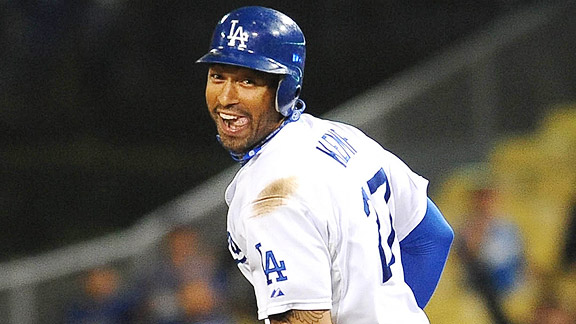
Jayne Kamin-Oncea/US PresswireMatt Kemp has had every reason to smile in ’11 — except the biggest: contending for the playoffs.
Like drivers who see a good parking space but hold out hope for a better one, even though, for crying out loud, the parking space right in front of them is absolutely all they need, the National League Most Valuable Player voters will select the Dodgers’ Matt Kemp for the honor only if they can’t envision an alternative.
With barely 25 percent of the 2011 regular season remaining (and if you thought “That much?” you’re not alone), Kemp and his .975 OPS, 31 steals in 36 attempts, 28 home runs and exceptional advanced stats (an NL-best .351 total average, according to Baseball Prospectus) are clearly in the thick of the MVP discussion — and he’s there despite playing the majority of his games in the same pitchers’ parks that some will hold against Clayton Kershaw in the NL Cy Young vote.
But by playing for a team that is on the express track to a losing season, Kemp will battle those who feel that the MVP must come from a more close-to-the-action team rather than one on the outer reaches of the mall.
Personally, long before I thought a Dodger would be in this kind of discussion, I’ve been in favor of giving the award to the best player regardless of the team’s record. Your value isn’t diminished by your surroundings, even if your surroundings are grim. I mean hey, would you dock Mother Teresa any Most Valuable Saint points because she was surrounded by also-rans? Heck no.
But the reality of a vote that hasn’t seen an NL MVP from a losing team since Andre Dawson in 1987 is fairly easy to suss.
As recently as 2009, Adrian Gonzalez of the San Diego Padres had a .407 on-base percentage, a .551 slugging percentage, 40 home runs and 99 RBI playing in a ballpark that is as smothering to batters as any in the NL. In wins above replacement, Gonzalez ranked fourth in the NL according to Baseball-Reference.com’s formula, sixth according to FanGraphs. In total average, Gonzalez was third.
Now, you’ll notice that Gonzalez wasn’t first in these categories, even the park-adjusted ones, so it’s not as if he had the right to feel cheated by not winning the MVP, which went unanimously to the dominant Albert Pujols of St. Louis. But somehow, Gonzalez finished not third, not sixth, but 12th, behind players who had inferior seasons at the plate … including Matt Kemp of the NL West-champion Los Angeles Dodgers, with an .842 OPS that was .116 below Gonzalez’s.
Kemp got credit for playing a more valuable defensive position and was viewed at the time as playing it well — that was his Gold Glove year. But Gonzalez finished fifth in the MVP vote even if you sift out first basemen, trailing Pujols, Ryan Howard, Prince Fielder and Derrek Lee.
Only Pujols had a better season than Gonzalez when park factors were taken into account. But Howard and Fielder also had more home runs than Gonzalez, and each played on a better team.
If there’s a silver lining to this ’09 flashback for those rooting for Kemp in 2011, it’s that voters put Fielder in fourth place even though he played for an 80-82 Brewers team that wasn’t much more relevant to the 2009 pennant chase than Gonzalez’s 75-87 Padres. Fielder’s 46 home runs (one behind Pujols) and 141 RBIs (tied with Howard for the league lead) were too gaudy to allow him to slide any lower.
Of course, we’re not questioning whether Kemp is Penske material. We’re wondering how likely it is that he’ll become the CEO. Here’s who might be considered the 10 finalists vying with Kemp for the big office.
- Albert Pujols. Thanks to a rougher-than usual start, Pujols is not as dominant as he was, although he hit his 29th home run Sunday to retake the National League lead from teammate Lance Berkman and Kemp. I’m not sure anyone playing the odds would expect Pujols to land anywhere below No. 1 in homers when the season ends. But the rest of his traditional stats are closer to mundane, and in advanced, untraditional numbers, he’s not really registering. A big September kick that propels St. Louis into the playoffs could certainly reopen his candidacy, but right now there’s almost no chance that a perceived down year for Pujols would outpoll Kemp.
- Lance Berkman. Pujols’ sidekick — who signed with St. Louis for $8 million this past offseason — trails Kemp in total average but by a slim .001. Kemp’s overall body of work (including 31 steals versus zero) should push the other Cardinals slugger aside, though.
- Jose Reyes. Considered by many to be the other top candidate from a noncontender, Reyes leads the NL in batting average and steals and has shortstop credentials to boot, but his OPS is far lower than Kemp’s, and now hamstring issues have sidelined him indefinitely. Believe it or not, Reyes is still on pace for the most triples in the NL since Kiki Cuyler had 26 in 1925, but Kemp is putting some distance between them.
- Troy Tulowitzki. Quietly, the Rockies star has become the shortstop to beat in the NL MVP race. According to FanGraphs, he co-leads the NL in wins above replacement and is by himself in fielding value, and he has a nice 23 home runs as the cherry on top. But speaking of Ripley’s, Colorado has actually fallen behind the Dodgers into fourth place in the NL West. That, plus the natural discount on Coors Field-boosted stats, has Tulo in Kemp’s rearview mirror.
- Andrew McCutchen. The Pirates outfielder’s long-running snub from the All-Star Game, which finally ended with a last-minute selection as a replacement, might have done more to boost his national profile than anything on the field. Pittsburgh was a surprise contender in the NL Central for most of the season, thanks as much to the 24-year-old McCutchen (a Gold Glove candidate with a bat) as anyone else. But like the Pirates, McCutchen has fallen on hard times lately and has a .684 OPS since the All-Star break.
- Joey Votto. The defending MVP (taking 31 of 32 first-place votes last year) has 19 home runs, barely half of last year’s 37, and his Reds are 11 games out of first place. He’s having a great season, no doubt (.949 OPS, 5.1 WAR, .408 wOBA, league-high 85 walks), but he’s not a threat to outpoll Kemp at this point.
- Prince Fielder. The aforementioned slugger has marquee stats (.985 OPS, 27 HR, 89 RBI) that resemble Kemp’s. Milwaukee — the Dodgers’ destination Monday — offers a nice showcase between the two players. His plate discipline is better (77 walks, 73 strikeouts), but — are you sitting down? — he has 31 fewer stolen bases. Fielder also plays first base, and not particularly adroitly. The Brewers have a five-game lead in the NL Central, though, and Fielder is the biggest reason, at least in size.
- Ryan Braun. Every year in Variety as the Emmys approach, we wonder aloud whether two nominees from the same well-regarded TV show will cancel each other out, opening the door for a third alternative. Braun (.965 OPS, 22 HR, 76 RBI, 22 steals) has worthy credentials, but his traditional numbers rate slightly below Kemp’s, as does his 5.1 WAR. The presence of Fielder and Braun on the same team could cause each to lose the inherent advantage of playing for a contender.
- Roy Halladay. The best players on the best team in the NL are, as you know, pitchers Halladay and Cliff Lee. The Phillies’ top position player, Shane Victorino, hasn’t even logged 100 games yet this year, while Howard’s .840 OPS as a first baseman isn’t gonna cut it. Halladay (154 ERA+, 2.51 ERA, 8.4 strikeouts per nine innings) and Lee (137, 2.83, 9.3), on the other hand, have been so good that one of them (slight edge to Halladay) will be a viable option for voters who don’t see why a great player on the undisputed regular-season champion shouldn’t win. A pitcher hasn’t won the NL MVP since Bob Gibson in 1968, but that might not be any less likely than Kemp’s becoming the first from a losing team to win since Dawson. Halladay is looking like a Hall of Famer, after all — voters aren’t going to dismiss him out of hand just because he’s on the mound. Not this year.
- Justin Upton. This one’s late-arriving on the radar, but coinciding with Arizona’s surge into the NL West lead is what’s becoming a monster season for Upton thanks to a 1.109 OPS since the All-Star break. Upton’s .379 on-base percentage, .564 slugging, 25 homers, 75 RBIs, 18 steals and .403 wOBA (weighted on-base average) all trail Kemp’s, but in most cases not by a ton — and Upton, a plus fielder, has moved ahead in WAR. This is a classic case of where, by the time the season ends, Kemp might lose the edge not because of what he did but because of what his teammates did.
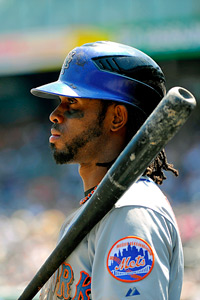
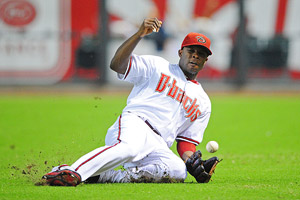
There are others who will get looks from voters, but no one better than the best on this list.
The NL MVP award is there for Kemp’s taking. But he’ll have to take it. He is absolutely going to need a finishing kick. Upton, in particular, is exactly the kind of player Kemp needs to watch out for — someone who meshes with his profile but who’s doing it with the pressure of a pennant race.
But it’s not just wishful thinking in a downtrodden Dodgers season to believe that Kemp will win the NL MVP. Not at all.
